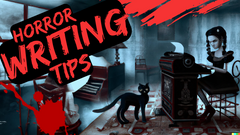10 Writing Tips to Give Your Horror Novel a Terrifying Edge
Here are ten writing tips that I've found to be effective when it comes to crafting a terrifying horror novel.

- Start with a strong hook.
Your opening sentence should grab the reader's attention and draw them into the story. A great horror hook will set the tone for the entire book and leave readers feeling unsettled right from the start. For example, "The howling wind carried with it the sound of scratching at my bedroom window, but when I looked outside, there was no one there."
- Create complex, flawed characters.
The best horror novels are built on a foundation of well-developed characters that readers can relate to and care about. These characters should be flawed, relatable, and human, with motivations and desires that drive the story forward. For example, a character struggling with addiction or mental illness might be vulnerable to the terrors they face.
- Build suspense through pacing.
The pacing of your horror novel should be deliberate and well-crafted, with moments of intense terror interspersed with slower, more introspective scenes. This creates a rollercoaster effect that keeps readers engaged and on the edge of their seats. For example, a tense chase scene might be followed by a quiet moment of reflection, giving readers a chance to catch their breath before the next scare.
- Use sensory details to create atmosphere.
The atmosphere of your horror novel is key to immersing readers in the story and making them feel like they're experiencing the horrors alongside the characters. To do this, use vivid sensory details that appeal to all five senses. For example, describe the smell of decay in an abandoned building or the cold, damp air of a misty forest. The old saying show, don't tell.
- Embrace the unknown.
One of the most effective ways to create fear in your readers is to leave some things unexplained or ambiguous. This allows their imaginations to run wild and fill in the gaps with their own worst fears. For example, a strange noise in the night might be more terrifying if the reader never finds out what caused it.
- Play on universal fears.
While the specific fears that your horror novel explores may be unique to your story, there are certain universal fears that all humans share. These might include fear of the dark, fear of death, fear of the unknown, or fear of losing control. By tapping into these primal fears, you can create a sense of terror that resonates with readers on a deep level.
- Use foreshadowing and symbolism.
Foreshadowing and symbolism are powerful tools in horror writing, allowing you to plant seeds of terror in your readers' minds and build a sense of unease that pays off later in the story. For example, a character might dream of drowning in a dark, swirling ocean, only to later find themselves trapped in a flooded basement.
- Create a unique monster or villain.
The monster or villain at the heart of your horror novel is what will keep readers up at night long after they've finished reading. To create a truly terrifying antagonist, focus on making them unique and memorable, with distinctive traits or characteristics that set them apart from other horror villains. For example, a killer who only strikes on rainy nights, or a monster that can only be seen in mirrors.
- Use dialogue to reveal character.
Dialogue is an important tool for revealing character in any genre, but it can be especially effective in horror writing. By using dialogue to show how your characters respond to fear and terror, you can build tension and deepen their relationships with one another. For example, a character might reveal their deepest fears to another during a moment of vulnerability.
- End with a twist.
A great horror novel should leave readers with a sense of unease, even after the story is over. One effective way to do this is by ending your horror novel with a twist that subverts readers' expectations and leaves them questioning everything they thought they knew about the story. For example, the final chapter might reveal that the protagonist was the real villain all along, or that the monster they were fighting was actually a misunderstood hero. A great horror novel should stick with readers long after they've finished reading, and a well-crafted twist can be the key to achieving this.
Writing a truly terrifying horror novel is a challenge, but by following these 10 tips, you can give your book the edge it needs to stand out in a crowded market. From creating complex, flawed characters to playing on universal fears and using sensory details to create atmosphere, every element of your horror novel can be crafted to maximize its impact on readers. By embracing the unknown, using foreshadowing and symbolism, and ending with a twist, you can leave readers feeling unsettled long after they've finished reading. With these tips in mind, go forth and write a horror novel that will keep readers up at night.
